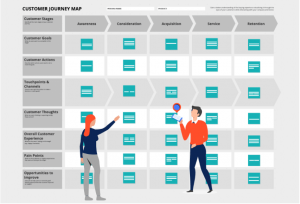Mapping is important to see how customer jumped from one brand to another
Customer journey mapping is a key part of many marketing strategies, and it holds added value for companies that have multiple brands.
“There is keen interest on how a customer moves from one brand to another,” said Pat Maigler, Senior Manager of Marketing Strategy and operations at Williams-Sonoma, in a recent MarTech Live session. “It all starts with data and there is a lot of data to get from a lot of sources.”
Tracking trends
Companies with multiple brands should look at trends, especially the particular order of brands a customer journey follows. Are they entering through lower priced brands? Does entrance come from brands with larger promotion and advertising budgets? Have customer journey trends changed since the COVID outbreak?
Traditional customer journey mapping often focused on major lifestyle milestone events like marriage, birth of a child and relocation. These indicators are still very important, but there are no countless more entry points to brand journeys, and an increase in non-linear lifestyles. Rather than limit your customer journey mapping by making predictable assumptions, look at where your customers actually are, and the needs they’re expressing.
Driven by data
All customer journey mapping should be driven by data, which includes: website and app engagement, offline data such as transaction data, social media conversations, email responses and service interactions.
Data trends should be compared to the ideal customer journey, to see where the gaps are and why they are occurring.
“There are a lot of signals that can really be informing you of what is going on [in the journey],” said Maigler. “The challenge is to understand the individual versus the household, that is the next big shift.”
This story first appeared on MarTech Today.
Marketing Land – Internet Marketing News, Strategies & Tips
(43)
Report Post







